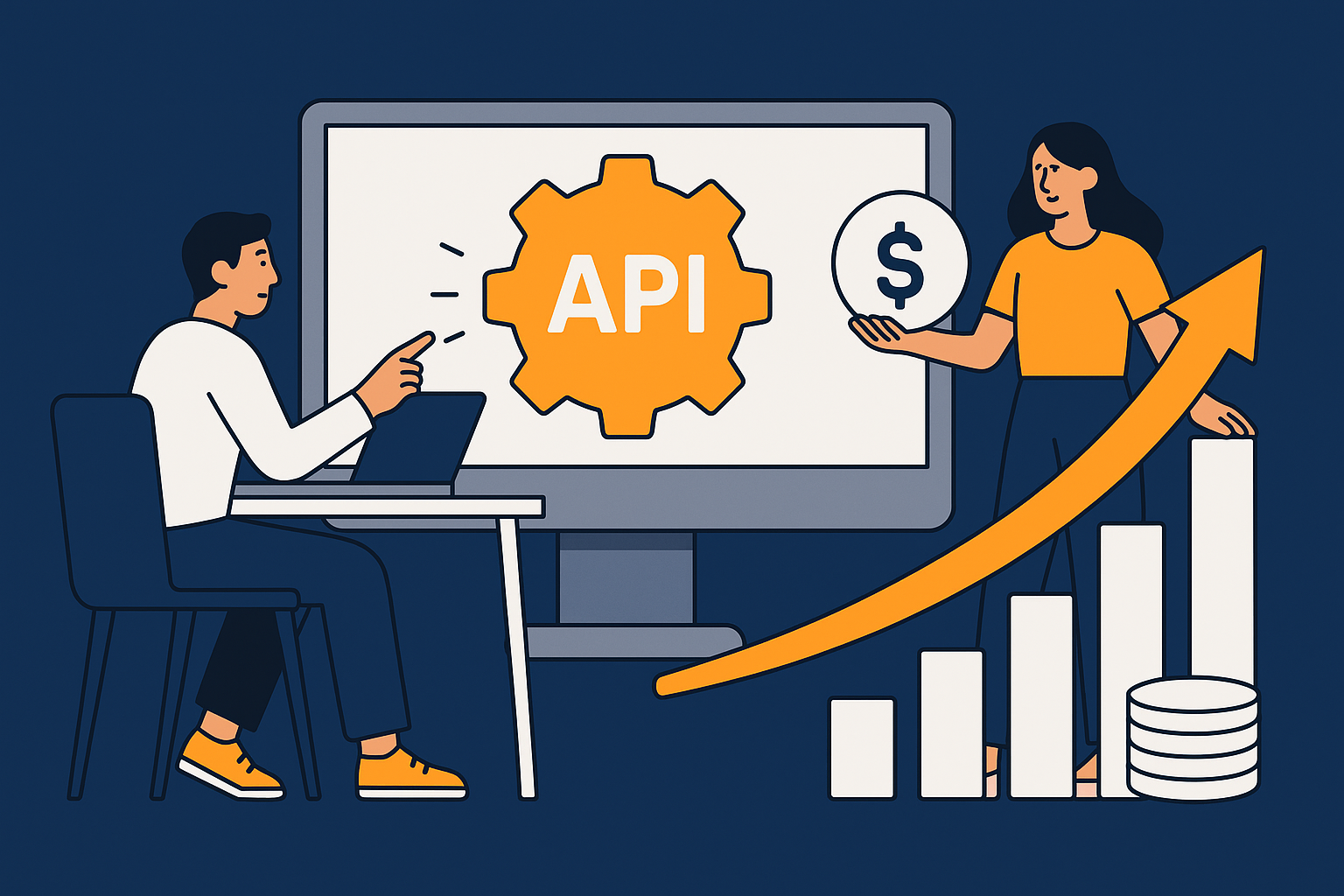Introduction
APIs have quietly become the connective tissue of modern platforms, partner ecosystems, and enterprise applications. Yet many organizations still treat APIs as a cost of doing business—useful for integrations, but not designed or operated as revenue-generating products. That’s a missed opportunity.
At CoreLine, we help leaders reframe APIs as strategic assets. With the right pricing model, metering infrastructure, entitlements, and developer experience, your APIs can drive net-new revenue, accelerate deals, and reduce custom integration costs. This article is a practical, business-first playbook for C‑level executives, product leaders, startup founders, and marketing directors who want to commercialize APIs without derailing the product roadmap.
Whether you’re a digital platform, a web application vendor, or an enterprise modernizing legacy services, this guide shows how to build an API business capability—step by step—and how a seasoned partner (a custom web app development agency with strong product consulting and UX/UI design capabilities) can de-risk each phase.
Event/Performer Details

- Topic focus: API monetization strategy, pricing architecture, metering and billing, developer experience (DX), packaging, and governance.
- Audience: CTO/CPO, product managers, heads of partnerships, enterprise architects, revenue operations, and marketing leaders.
- Outcomes: A 90-day plan to pilot paid APIs; architecture components you’ll need; a go-to-market packaging model; KPIs that connect DX to revenue.
Why APIs deserve a product P&L
APIs can unlock three bottom-line levers:
- Direct revenue: tiered, usage-based, or event-based pricing.
- Indirect revenue: faster enterprise deals through integration readiness, accelerating time-to-value for customers and partners.
- Cost avoidance: standardized interfaces reduce custom statements of work and lower integration maintenance.
Framed correctly, an API portfolio gets its own mini P&L with measurable CAC and LTV, attach rates to your core product, and expansion revenue via higher tiers or premium endpoints.
The monetization model stack
Design price and packaging around the unit of value customers actually care about, not just what’s easy to meter.
- Value metrics (choose 1–2 max):
- Transactions/events (e.g., API calls that create business outcomes).
- Records processed (documents, items, messages).
- Entities managed (active users, devices, locations).
- Compute/time (batch minutes, inference seconds for ML).
- Pricing patterns:
- Usage-based with committed minimums (predictable for finance, scalable for customers).
- Tiered bundles (Starter, Growth, Enterprise) with hard/soft limits.
- Seat-plus-usage for admin-facing APIs (combine roles with consumption).
- Embedded/partner rev-share for marketplace distribution.
- Entitlement tactics:
- Gating by endpoint family (read-only vs. write).
- Feature flags for premium capabilities (webhooks, bulk, SLAs).
- Rate limits per plan and per integration key.
- Regional controls for data residency and compliance.
Tip: Avoid pricing directly on raw “requests.” If a single business operation requires multiple requests, you’ll create confusion and billing disputes. Map requests to billable events that match customer outcomes.
Metering and entitlements: the technical backbone
Monetization fails without reliable usage data and real-time access control. Minimum viable architecture:
- Identity and auth:
- API keys for server-to-server, OAuth for delegated access, optional mTLS for high-trust scenarios.
- Key rotation and per-integration credentials to isolate abuse and simplify revocation.
- Entitlements service:
- Central service to resolve “can this principal call this endpoint at this rate in this region?” in milliseconds.
- Reads from subscription catalog (plan, add-ons, trials), writes to audit log.
- Usage capture:
- Durable, idempotent event stream (e.g., gateway logs to a message bus) enriched with tenant, endpoint, plan, region, and correlation IDs.
- At-least-once delivery with de-duplication at the aggregator.
- Billing pipeline:
- Near real-time aggregation to a usage warehouse (daily and monthly rolls).
- Export to billing provider; maintain your own truth source to reconcile vendor bills and handle credits/adjustments.
- Observability:
- SLOs for authorization latency, quota accuracy, and event pipeline freshness.
- Finance-grade reconciliation dashboards; monthly close automation.
This is where an experienced digital product design agency and engineering partner proves its value: aligning service boundaries, latency budgets, and data contracts so monetization logic is reliable, explainable, and auditable.
Packaging that sales and procurement can actually close
Great pricing can still lose in procurement if packaging and evidence are weak. Make it easy to buy and easy to justify:
- Tier design:
- Anchor tiers on use cases (evaluation, production, mission-critical).
- Publish “allowed integrations,” peak throughput, webhook/delivery guarantees, and support SLAs per tier.
- Evidence pack:
- Security and compliance data sheet (encryption, data retention, subprocessor list).
- Integration guide with “Day 0–Day 7” implementation steps and code samples.
- ROI calculator with two or three validated scenarios.
- Contract hygiene:
- Clear usage definitions, overage rates, and throttling behavior.
- Disaster recovery RTO/RPO commitments where relevant.
- Data residency statement and regional failover policy for enterprise application development buyers.
Developer experience (DX) that converts
Developer-centric funnels are measurable. Track and optimize:
- Time to First Hello World (TTFHW): target minutes.
- Time to First Value (TTFFV): a complete end-to-end business outcome in hours or days.
- Sandbox reliability: aim for 99.9%+ so pilots aren’t blocked.
- Docs depth: runnable snippets in popular languages, error catalog with remediation, and reference + task guides.
- Change management: versioning, deprecation schedules, and migration playbooks.
- Support channels: Slack community or forum plus premium support SLAs in paid tiers.
UX/UI details matter here. Microcopy in error messages, consistent pagination and filtering semantics, and well-structured examples often move conversion more than flashy portals.
A 90-day pilot plan (doable without derailing your roadmap)
You don’t need to boil the ocean. Here’s a pragmatic, risk-weighted sequence we routinely lead:
- Days 0–14: Monetization hypothesis
- Select 1–2 API families tied to clear outcomes.
- Define value metric, three tiers, guardrails, and success KPIs.
- Draft entitlement and metering events; align legal on definitions.
- Days 15–30: Technical enablement
- Instrument gateway for usage events; build minimal entitlement checks.
- Stand up a usage aggregator and daily rollups; connect to billing sandbox.
- Ship “Hello World” sample app and Quickstart docs.
- Days 31–60: Limited beta
- Invite 5–10 design partners. Issue keys, trial entitlements, and test overage behavior.
- Validate TTFHW/TTFFV; iterate on docs and SDKs.
- Run willingness-to-pay interviews; refine price fences.
- Days 61–90: Commercial readiness
- Finalize plan matrix, SLAs, and order form.
- Launch developer portal updates; publish deprecation/version policy.
- Train sales/solutions; release ROI calculator; set up monthly close and reconciliation.
By the end of Day 90, you should have billable usage flowing in a controlled scope, real customer feedback, and a repeatable onboarding motion.
Governance and risk you can show to the board
Monetization raises new risks; address them up front:
- Abuse and fraud: per-integration keys, rate limits, velocity alerts, and anomaly detection on atypical usage.
- Privacy and residency: attribute region and data class to usage events; enforce geo-fences at entitlement time.
- SLA posture: design SLOs for developer-critical journeys (auth, quota check, docs, sandbox), connect them to credits in your SLA.
- Backward compatibility: semantic versioning, long-lived support windows for enterprise integrations, and feature flags to decouple release risk.
- Revenue recognition: align consumption events with finance policy; tag trials, credits, and adjustments for audit-ready analytics.
Example scenario (anonymized)
A logistics platform had robust internal APIs but mounting custom integration costs. In 12 weeks, they:
- Productized two API families with value metrics tied to shipments processed.
- Implemented a lightweight metering bus and daily aggregation to their billing provider.
- Published a “7‑day integration plan” and SDKs for Node/.NET.
- Moved three strategic partners to paid tiers with committed usage minimums.
Results within two quarters: 18% reduction in custom integration backlog, 11% net-new ARR from API attach, and shorter enterprise sales cycles due to procurement-ready evidence.
Why You Shouldn’t Miss It
- Actionable blueprint to turn APIs into a revenue line without rewriting your stack.
- Clear alignment between business metrics (ARR, attach, LTV) and DX metrics (TTFHW, sandbox SLOs).
- Architecture patterns that finance and security can approve.
- A 90-day plan sized for real-world teams with existing roadmaps.
- Practical packaging and evidence that accelerates enterprise procurement.
- Guidance spanning strategy, UX content, engineering, and operations—one integrated approach rather than siloed advice.
Practical Information
- Team you’ll need:
- Product lead (pricing/packaging), API architect, platform engineer, designer/technical writer, finance ops partner, security lead.
- Core components:
- API gateway with per-key policies; entitlement service; metering bus; usage warehouse/aggregator; billing provider integration; developer portal; observability (SLOs, dashboards).
- Timeline and effort:
- 8–12 weeks for a limited-scope pilot; parallelize documentation/SDK work with metering buildout.
- Budget signals:
- Expect initial investment to focus on engineering time for entitlements and metering, plus portal/documentation upgrades. Keep billing vendors modular to avoid lock-in.
- Success KPIs:
- Conversion from key issued → first successful call → first end-to-end outcome.
- Percentage of paid tenants using at least one premium endpoint.
- Overages recovered vs. credits issued.
- Support tickets per 1,000 calls (should decline as docs improve).
- Where CoreLine fits:
- Strategy: value metric modeling, price fences, and multi-tier packaging.
- Design: developer portal IA, reference + task docs, example apps, and error microcopy.
- Engineering: entitlements, metering, usage aggregation, and gateway policies across regions.
- Operations: SLO design, SLA mapping, reconciliation, and monthly close automation.
- Adjacent help: mobile app consulting for partner integrations, and enterprise application development for secure, region-aware rollouts.
Conclusion
API monetization isn’t just a pricing exercise. It’s a cross-functional capability that combines product strategy, UX for developers, robust platform engineering, finance-grade metering, and credible governance. Done well, it creates a defensible growth engine, shortens enterprise sales cycles, and reduces integration overhead—without hijacking your roadmap.
If you’re ready to evaluate your API portfolio, establish value metrics, and stand up the metering and entitlement backbone, our team can lead the end-to-end pilot and hand over a scalable operating model.






